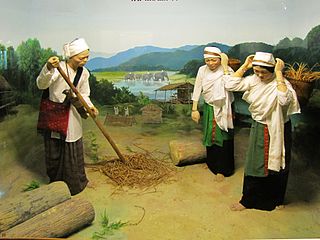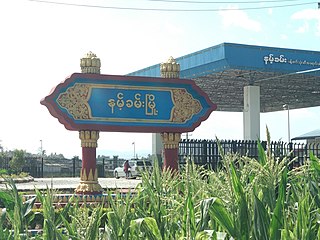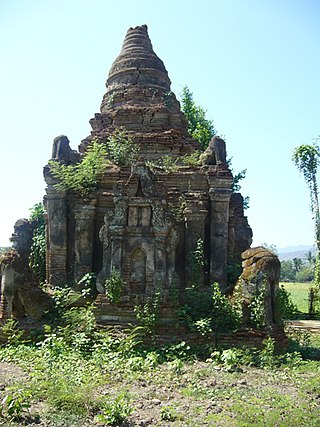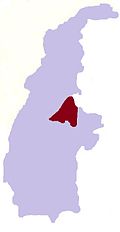
The Dai people are several Tai-speaking ethnic groups living in the Xishuangbanna Dai Autonomous Prefecture and the Dehong Dai and Jingpo Autonomous Prefecture of China's Yunnan Province. The Dai people form one of the 56 ethnic groups officially recognized by the People's Republic of China. By extension, the term can apply to groups in Laos, Vietnam, Thailand and Myanmar when Dai is used to mean specifically Tai Yai, Lue, Chinese Shan, Tai Dam, Tai Khao or even Tai in general. For other names, see the table below.

The Jingpo people is an ethnic group who are the largest subgroup of the Kachin peoples. The greater name for all the Kachin peoples in their own Jingpo language is the Jinghpaw. Other endonyms include Zaiwa, Lechi, Lisu, Maru, Hkahku, etc.

Fo Guang Shan (FGS) (Chinese: 佛光山; pinyin: Fó guāng shān; lit. 'Buddha's Light Mountain') is an international Chinese Mahāyāna Buddhist organization and monastic order based in Taiwan that practices Humanistic Buddhism whose roots are traced to the Linji school of Chan Buddhism. The headquarters, Fo Guang Shan Monastery, is located in Dashu District, Kaohsiung, and is the largest Buddhist monastery in Taiwan. The organization is also one of the largest charity organizations in Taiwan. The organization's counterpart for laypeople is known as the Buddha's Light International Association.

Sagaing Region is an administrative region of Myanmar, located in the north-western part of the country between latitude 21° 30' north and longitude 94° 97' east. It is bordered by India's Nagaland, Manipur, and Arunachal Pradesh states to the north, Kachin State, Shan State, and Mandalay Region to the east, Mandalay Region and Magway Region to the south, with the Ayeyarwady River forming a greater part of its eastern and also southern boundary, and Chin State and India to the west. The region has an area of 93,527 square kilometres (36,111 sq mi). In 1996, it had a population of over 5,300,000 while its population in 2012 was 6,600,000. The urban population in 2012 was 1,230,000 and the rural population 5,360,000. The capital city and the largest city of Sagaing Region is Monywa.

Shan State is a state of Myanmar. Shan State borders China (Yunnan) to the north, Laos to the east, and Thailand to the south, and five administrative divisions of Myanmar in the west. The largest of the 14 administrative divisions by land area, Shan State covers 155,800 km2, almost a quarter of the total area of Myanmar. The state gets its name from Burmese name for the Tai peoples: "Shan people". The Tai (Shan) constitute the majority among several ethnic groups that inhabit the area. Shanland is largely rural, with only three cities of significant size: Lashio, Kengtung, and the capital, Taunggyi. Taunggyi is 150.7 km northeast of the nation's capital Naypyitaw.

The Karen, also known as the Kayin, Kariang or Kawthoolese, are an ethnolinguistic group of Tibeto-Burman language-speaking people. The group as a whole is heterogeneous and disparate as many Karen ethnic groups do not associate or identify with each other culturally or linguistically. These Karen groups reside primarily in Kayin State, southern and southeastern Myanmar. The Karen account for around 6.69% of the Burmese population. Many Karen have migrated to Thailand, having settled mostly on the Myanmar–Thailand border. A few Karen have settled in the Andaman and Nicobar Islands, India, and other Southeast Asian and East Asian countries.

Hanshan was a Chinese Buddhist monk, poet, and spiritual writer during the Tang dynasty. He was a Chinese Buddhist and Taoist figure associated with a collection of poems from the Chinese Tang dynasty in the Taoist and Chan tradition. No one knows who he was, when he lived and died, or whether he actually existed. In the Chinese Buddhist tradition, Hanshan and his sidekick Shide are honored as emanations of the bodhisattvas Mañjuśrī and Samantabhadra, respectively. In Japanese and Chinese paintings, Hanshan is often depicted together with Shide or with Fenggan, another monk with legendary attributes.

Fo Guang University is a private university in Linmei Village, Jiaoxi Township, Yilan County, Taiwan. It was founded by the Chinese Mahāyāna Buddhist monastic order Fo Guang Shan in 2000 and as such represents the culmination of education efforts of the order that started in 1963 with establishing Chinese Buddhist Research Institute at Fo Guang Shan.

Barguna is a district in the division of Barisal, in southern Bangladesh. Barguna subdivision was established in 1969 and promoted to a district on 28 February 1984.

The Pa'O are the ethnic minorities living in Myanmar, with a population of roughly 1,200,000

The Tai Khamti, also known as the Hkamti Shan or simply as Khamti, are a Tai ethnic group of India, China and Myanmar. The Tai-Khamti are followers of Theravada Buddhism. The Tai-Khamti have their own script for their language, known as 'Lik Tai', which originated from the Shan (Tai) script of Myanmar. Their mother tongue is known as Khamti language. It is a Tai language, closely related to Thai and Lao.
Lewe Township is one of eight townships of Naypyidaw Union Territory, Burma.
Lewe is a town in the Naypyidaw Union Territory of central Myanmar.

Kengtung Township is a township of Kengtung District in the Shan State of Myanmar. The principal town is Kengtung. It lies almost entirely east of the Salween River and its area is over 12,000 square miles (31,000 km2). It is bounded on the north by the states of Mang Lon, Mong Lem and Keng Hung ; east by the Mekong River, south by the Siamese Shan States, and west in a general way by the Salween River, though it overlaps it in some places. The state is known to the Chinese as Mhng Khng, and was frequently called by the Burmese the 32 cities of the Gn (HkOn). The classical name of the state is Khemarata or Khemarata Tungkapuri.

Zhudong Township is an urban township in central Hsinchu County, Taiwan. Part of Hsinchu Science Park is in Zhudong. Also located in Zhudong is the main campus of the Industrial Technology Research Institute (ITRI). Zhudong is approximately 20 minutes drive from Hsinchu town center on one of two freeways, route 3 North, which passes nearby and route 68 East which proceeds directly through Zhudong.

Qiongzhu Temple, or Bamboo Temple, is a Buddhist temple situated on Yu'an Mountain to the northwest of Kunming, Yunnan, China. The name of the temple (Qiongzhu) refers to a type of bamboo. The Bamboo Temple was established during the Yuan dynasty as the first temple dedicated to Zen Buddhism in Yunnan. It has since been burned down and reconstructed several times. The present structure mostly dates from the late Qing dynasty.

Namhkam, also spelled Nam Kham is the principal town of Namhkam Township in northern Shan State, Myanmar, situated on the southern bank of the Shweli River near the border with Yunnan Province, China.

Sidoktaya, also Sitoktaya or Setoketaya is a town and seat of Sidoktaya Township in Minbu District of Magway Division, situated in middle west region of Burma. It is bordered with Salin township to the east, with Pwintbyu township to the south-east, with Ngape township to the south, with Minbya township to the west, with Kanpelek township to the north-west and with Saw township to the north. It is a hilly region of Rakhine. Mount Sun Taung, the highest mountain in Rakhine, 6,527 feet (1,989 m) high, is in Sidoktaya township.

The Wa States was the name formerly given to the Wa Land, the natural and historical region inhabited mainly by the Wa people, an ethnic group speaking an Austroasiatic language. The region is located to the northeast of the Shan States of British Burma, in the area of present-day Shan State of northern Myanmar (Burma) and the western zone of Pu'er Prefecture, Yunnan, China.

Phongyibyan is a Burmese language term for the ceremonial cremation of high-ranking Buddhist monks, in particular monks from Myanmar's largest Buddhist order, the Thudhamma Nikaya.



















